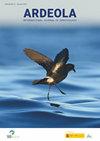亚速尔秃鹰的相对丰度及其对土地利用的响应
IF 1.2
4区 生物学
Q2 ORNITHOLOGY
引用次数: 0
摘要
总结。对亚速尔秃鹰(Buteo Buteo rothschildi)的相对丰度进行了时间和空间评估,以确定其土地利用偏好并支持其保护。主要目的是比较不同年份、岛屿和地点之间的相对丰度,并将这些与生境变化背景下的土地利用联系起来。采用条带样带和点计数两种抽样方法对随机选取的样地进行调查,记录在繁殖季节看到的任何秃鹰,并评估土地利用特征。不出所料,秃鹰在最大的岛上(本文章由计算机程序翻译,如有差异,请以英文原文为准。
Relative Abundance of the Azorean Buzzard Buteo Buteo Rothschildi and its Responses to Land Use
Summary. The relative abundance of the Azorean Buzzard Buteo buteo rothschildi, both temporally and spatially, was assessed to determine its land use preferences and to support its conservation. The main aims were to compare its relative abundance between years, islands and localities and to relate these to land use in the context of habitat changes. Randomly selected plots were surveyed using two sampling methods: strip transect and point counts, to record any buzzards seen during the breeding season and to assess land use characteristics. The buzzards were most numerous on the largest island (São Miguel), and least numerous on the smallest one (Graciosa), as expected. However, we did not find significant differences in abundance among localities in Graciosa or between years in both islands. We only found local variation in abundance on S. Miguel. The overall population stability clearly favours the conservation of this Azorean endemic subspecies. Finally, we found that buzzards avoid industrial areas, urbanisation, natural vegetation and agricultural land, a finding that should be kept in mind by policymakers. These results may be used for landscape planning and management by authorities. There are several regional Management Plans with a spatial dimension but for land use classification the Municipal Master Plans have the discretionary power to classify urban and rural areas. Therefore, this information should be integrated into the decision process of the local classification actions. Future studies should include further habitat variables to assess their relationships with buzzard abundance, but also to extend the analyses to the remaining Azorean Islands in order to understand more deeply how this insular raptor responds to habitat changes. The results of these studies should strengthen law enforcement on land use sustainability and help to promote awareness among managers, landowners, stakeholders and the general public. —Lopes, M., Pereira, D.G., Afonso, A. and Melo, F. (2019). Relative abundance of the Azorean Buzzard Buteo buteo rothschildi and its responses to land use. Ardeola, 66: 343-360.
求助全文
通过发布文献求助,成功后即可免费获取论文全文。
去求助
来源期刊
CiteScore
2.30
自引率
6.20%
发文量
16
审稿时长
>12 weeks
期刊介绍:
Ardeola: International Journal of Ornithology is the scientific journal of SEO/BirdLife, the Spanish Ornithological Society. The journal had a regional focus when it was first published, in 1954. Since then, and particular during the past two decades, the journal has expanded its thematic and geographical scope. It is now a fully international forum for research on all aspects of ornithology. We thus welcome studies within the fields of basic biology, ecology, behaviour, conservation and biogeography, especially those arising from hypothesis-based research. Although we have a long publication history of Mediterranean and Neotropical studies, we accept papers on investigations worldwide.
Each volume of Ardeola has two parts, published annually in January and July. The main body of each issue comprises full-length original articles (Papersand Review articles) and shorter notes on methodology or stimulating findings (Short Communications). The publication language is English, with summaries, figure legends and table captions also in Spanish. Ardeolaalso publishes critical Book Reviewsand PhD-Dissertation Summaries; summarising ornithological theses defended in Spain. Finally there are two Spanish-language sections, Ornithological News; summarising significant recent observations of birds in Spain, and Observations of Rare Birds in Spain, the annual reports of the Spanish Rarities Committee.

 求助内容:
求助内容: 应助结果提醒方式:
应助结果提醒方式:


